
Nuts are a versatile and popular ingredient in commercial kitchens, adding flavor, texture, and nutritional value to everything from salads to baked goods. Selecting the right nut for your recipe can elevate the flavor and presentation of your dishes. From their shape to their best uses, reference this guide to elevate the taste and texture of cookies, trail mix, and charcuterie boards.
Shop All Wholesale NutsWhat Is a Nut?
In botanical terms, a nut is strictly categorized as a dry fruit with a single seed, a hard shell, and a protective husk. Chestnuts, hazelnuts, pecans, and walnuts, fit this precise botanical definition. Interestingly, common items we often refer to as nuts, such as peanuts and almonds, do not meet the botanical definition of a nut. Despite this, they are still commonly grouped with true nuts in culinary contexts due to their similar characteristics and uses.
Seeds vs Nuts
Seeds are the small reproductive units of a plant that contain the genetic material necessary for the growth and development of a new plant. Nuts are a type of seed enclosed in a hard, inedible shell that typically grows on trees. This means that while all nuts are seeds, not all seeds are considered nuts.
List of Nuts
We provide a list of the most popular types of nuts with pictures so you can easily identify and differentiate them.
1. Pistachio
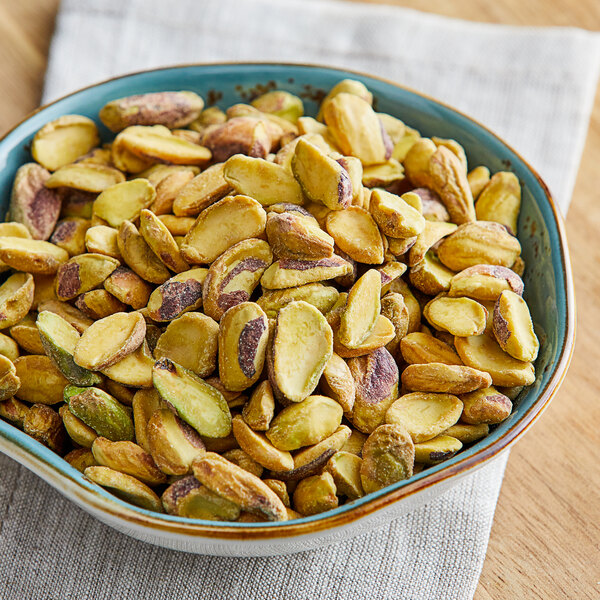
Pistachios, scientifically known as Pistacia vera, are a culinary nut ranging in color from yellowish to bright green, with the more vibrantly hued specimens being more prized. Pistachios are described as meaty yet sweet, with a distinctive combination of flavors that includes notes of fruity avocado, olive, and earthy mushrooms. They are also prized for their crunchy texture, which adds a satisfying element to various recipes.
On the tree, pistachios are reddish, wrinkled fruits that grow in heavy clusters reminiscent of a bunch of grapes. The husked fruit contains a thin, ivory-colored, bony shell that splits longitudinally along its sutures when mature. Inside the shell is the kernel, what we commonly refer to as the nut, which is about one inch in length and a half-inch in diameter. Native to semi-arid climates in Central Asia, pistachios are harvested anywhere from late August to early October.
- What Do Pistachios Look Like? Pistachios are small, oval-shaped nuts with a hard, beige shell that splits open when ripe, revealing a yellow to vibrant green kernel inside. The shell of a pistachio is naturally beige with a slightly purplish hue and is often dyed red to enhance its appearance.
- What Do Pistachios Taste Like? Buttery and mildly sweet
- Best Uses for Pistachios: Turkish delight, baklava, salads, charcuterie boards, pasta, trail mix, ice cream
- How to Open a Pistachio: Hold the pistachio between your thumb and index finger and gently squeeze until the shell cracks. Be careful not to apply too much force, as this can crush the nut inside.
- How to Store Pistachios: To store pistachios, place them in an airtight container and keep them in a cool, dry place like the refrigerator for the best freshness; for longer-term storage, you can freeze them in an airtight container as well.
2. Walnut
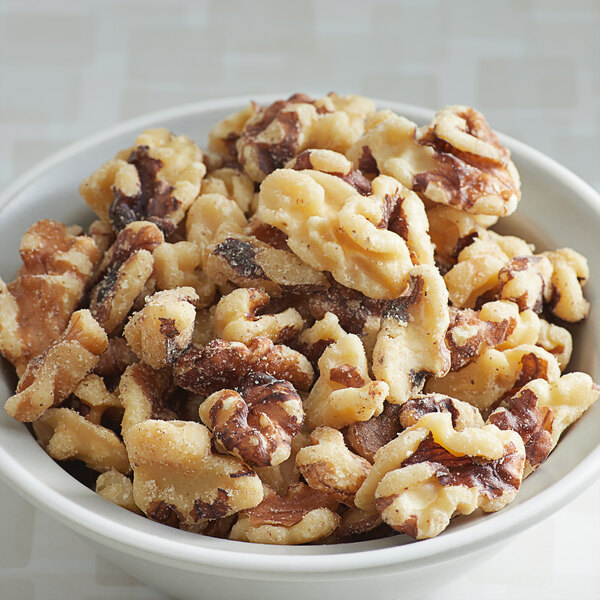
Walnuts, scientifically named Juglans regia, are a type of tree nut that belongs to the walnut family. They are round, single-seeded stone fruits with a brown, wrinkly shell. The shell is enclosed in a husk that becomes brittle during ripening, making it easy to crack open to access the kernel. The kernel is typically found in two halves, which are commonly known as the walnut "meat." In the Northern Hemisphere, walnuts ripen between September and November.
Walnuts originated in the Mediterranean region and Central Asia and have been a part of the human diet for thousands of years. They are now widely cultivated and enjoyed. Popular varieties of walnuts include English walnuts, Persian walnuts, and Eastern black walnuts. They have an earthy, slightly bitter flavor that completes savory dishes or serves as a contrasting element in confectionaries like fudge.
- What Do Walnuts Look Like? A walnut shell is typically round- or oval-shaped and varies in color from light brown to dark brown. Inside, the seed is light-colored, ridged, and shaped similarly to a human brain.
- What Do Walnuts Taste Like? Earthy, creamy, and slightly bitter
- Best Uses for Walnuts: Walnut oil, pastries, bread, ground into a paste to create savory sauces and dips
- How to Open a Walnut: Using a nutcracker, gently apply pressure to the center of the shell until it cracks open. Remove the shell to reveal the delicious walnut meat inside.
- How to Store Walnuts: Store walnuts in an airtight container or resealable bag in the refrigerator or freezer. Walnuts can absorb odors from other foods, so it is best to store them away from strong-smelling items.
Black Walnut vs Walnut
Black walnuts are a type of walnut known for its bold, earthy flavor and rich, oily texture. They have a stronger taste compared to traditional English walnuts, but they also come at a higher price point. English walnuts, also known as Persian walnuts, have a milder taste and a softer texture than black walnuts.
3. Peanut
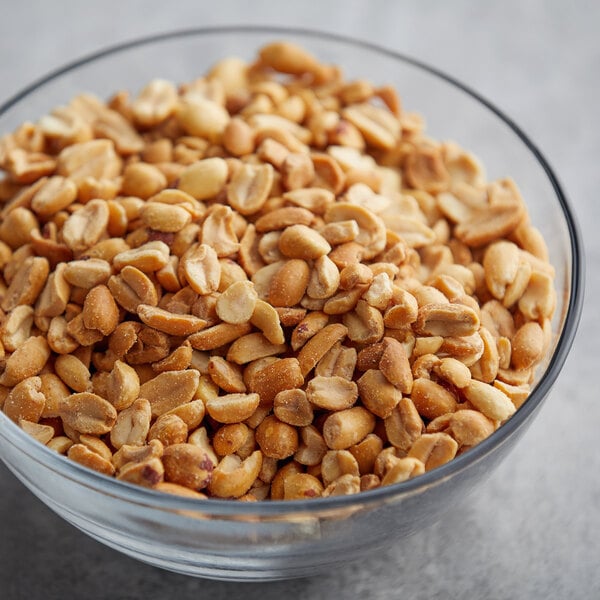
Despite their name, peanuts are technically legumes, belonging to the same family as beans and lentil varieties. They are also commonly referred to as groundnuts because they grow underground, with the peanut plant producing yellow flowers that eventually wilt and bend toward the ground, where the peanuts develop. The peanuts are encased in a thin, papery shell that splits open when they mature. Peanuts are typically planted in the spring and harvested in the fall. They thrive in warm climates and are a staple crop in many regions worldwide.
Scientifically known as Arachis hypogaea, peanuts reveal their legume origins with their beany, earthy flavor. This savory taste is undercut by a slightly sweet undertone that becomes more pronounced when roasted. They can be enjoyed roasted and salted as a snack, ground into peanut butter, or used in various recipes such as stir-fries, sauces, and baked goods. Whether you're making a classic kid's menu item like a peanut butter and jelly sandwich or Thai peanut sauce for spring rolls, peanuts are a beloved ingredient worldwide. Operators must take into account that peanuts are a common allergen in the United States and can elicit severe allergic responses in certain individuals.
- What Do Peanuts Look Like? Peanuts are encased in light tan, hard, wrinkled pods. The pods are between 1 and 3 inches long and contain one to four seeds each. The seeds are white with pale brown skins.
- What Do Peanuts Taste Like? Beany, rich, earthy, and slightly sweet
- Best Uses for Peanuts: Peanut butter, trail mix, boiled peanuts, cookies, brownies
- How to Open Peanuts: Start by grasping the shell between your thumb and forefinger, then apply pressure to crack it open. Carefully separate the cracked shell to remove the peanut inside.
- How to Store Peanuts: Peanuts should be stored in airtight containers to prevent moisture and pests from affecting the product. It is recommended to store peanuts away from strong odors and direct sunlight to preserve their flavor.
4. Chestnut
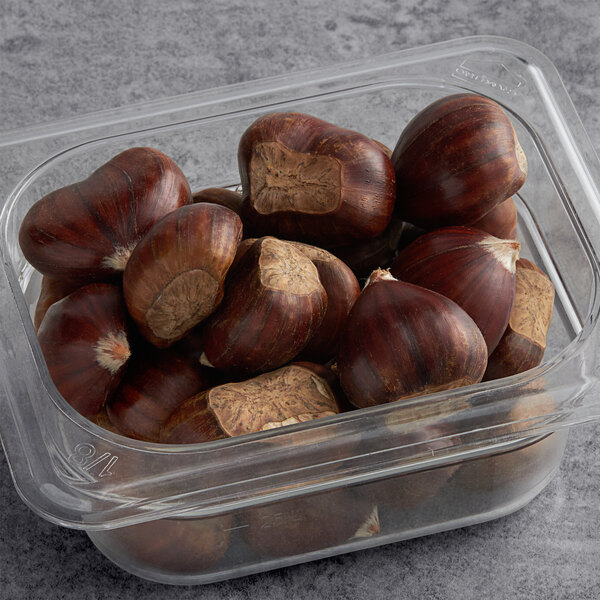
Chestnuts, scientifically known as Castanea, are typically in season during the fall and winter months, making them a staple ingredient in holiday dishes and desserts. Their spiky outer shell that encases their smooth, shiny brown nuts inside makes chestnuts visually distinct. Unlike most nuts, chestnuts are high in carbohydrates and low in fat, making them a popular choice for those seeking a nutritious snack.
Chestnuts are mild and slightly sweet, with a creamy texture that sets them apart from other nuts like almonds or walnuts. One of the key features of chestnuts is their versatility in culinary applications. They can be roasted, boiled, or pureed to create everything from savory stuffings to sweet desserts. Additionally, chestnuts can be candied, dried, or ground into a paste.
- What Do Chesnuts Look Like? Chesnuts are characterized by their round shape and hard, spiky, dark brown outer shell. Once the shell is cracked open, the nut inside is light brown, smooth, and shiny. Their shapes range from flattened, to triangular, to rounded and are pointed at one end.
- What Do Chestnuts Taste Like? Sweet and creamy
- Best Uses for Chestnuts: Roasted and served as a snack, tarts, cakes, quick breads
- How to Open Chestnuts: To open a chestnut, start by scoring an "X" on the flat side of the nut to prevent it from exploding during cooking. Then, roast or boil the chestnuts until the skin peels back. Remove the peeling skin and reveal the tender, creamy nut inside.
- How to Store Chestnuts: Chestnuts should be stored at temperatures between 33 to 34 degrees Fahrenheit with humidity levels around 90%. To maintain their freshness and flavor, use chestnuts within two weeks of storage for the best quality.
Horse Chestnuts vs Edible Chestnuts
Horse chestnuts and edible chestnuts are often confused due to their similar names, but they are quite different in terms of consumption and usage. Horse chestnuts, also known as conkers, are not edible for humans and are toxic if consumed raw. They are commonly used in crafts and as decorative items. Edible chestnuts are safe for human consumption and are a beloved winter flavor, especially when roasted over an open fire and served at Christmas markets.
5. Pecan
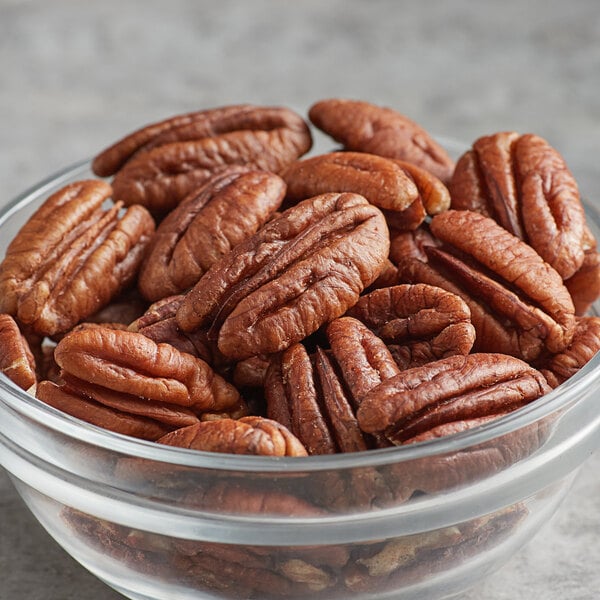
Pecans, scientifically known as Carya illinoinensis, are prized for their rich, creamy taste with a slightly sweet undertone. What sets pecans apart visually is their elongated shape, smooth reddish-brown shell, and the characteristic grooves on the nut's surface. Pecans are harvested in the fall, typically from September to November, making them a seasonal delight for many chefs and bakers.
Pecans are used in various culinary applications, including baked goods such as pecan pies, cookies, and muffins. They are also a popular addition to salads, granolas, and trail mixes. Pecans can be ground into a fine powder to create pecan flour, which is used in gluten-free baking. Additionally, pecans are commonly used in savory dishes as a coating for proteins or as a topping for salads and vegetables.
- What Do Pecans Look Like? Pecan shells are smooth, hard, thin, and oval-shaped. The outer shell is dark brown, while the nutmeat is oblong with deep ridges.
- What Do Pecans Taste Like? Buttery, sweet, and rich
- Best Uses for Pecans: Pecan pie, cookies, muffins, salads, yogurt toppings, oatmeal toppings
- How to Open Pecans: Place a pecan in a nutcracker and gently squeeze until the shell breaks, revealing the delicious pecan meat.
- How to Store Pecans: Pecans should be stored in an airtight container in a cool, dry place away from sunlight and heat sources. Refrigeration or freezing can extend their shelf life.
Pecan Pronunciation
How people pronounce the word pecan varies based on regional dialects. In the Southern United States, the word pecan is typically pronounced as "pee-can," emphasizing the first syllable. People in the Northern United States tend to say "puh-kahn," emphasizing the second syllable. Neither pronunciation is expressly right or wrong.
Pecans vs Walnuts
Walnuts are known for their round, wrinkled shells and brain-like shape, while pecans have more oval-shaped shells and a smooth surface. Pecans boast a luxurious, buttery taste and satisfying crunch, making them a favored ingredient in recipes. With a milder flavor profile and a hint of bitterness, walnuts are commonly used in baked goods, salads, granola, and as a topping for yogurt or oatmeal. Pecans tend to be pricier than walnuts due to their intricate harvesting and shelling process, as well as their limited cultivation areas.
Back to Top6. Hazelnut
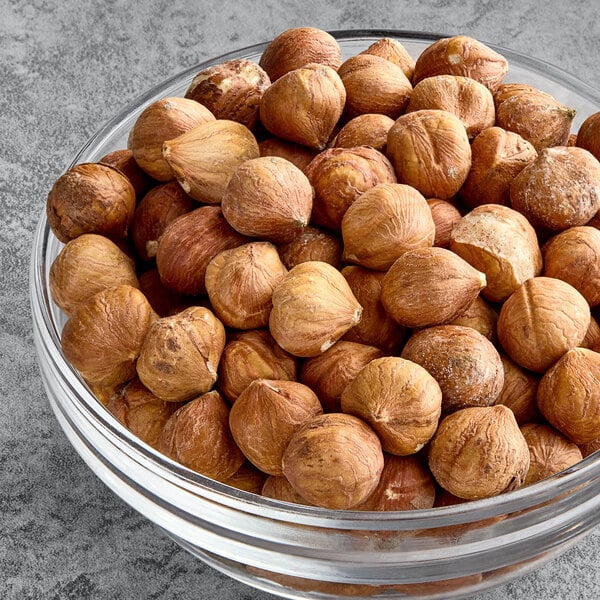
Hazelnuts, scientifically known as Corylus avellana, are typically harvested in the fall, making hazelnut-flavored items a fun fall flavor. These nuts are easily recognizable by their round shape and hard shell that encases a small, cream-colored kernel. Hazelnuts are distinctive for their rich, buttery, slightly sweet flavor with a chocolate undertone.
Also known as filberts, hazelnuts can be eaten raw or roasted to enhance their caramelized notes and sweetness. Hazelnuts are commonly used in baking, adding a delightful crunch and nutty flavor to cookies, cakes, and pastries. One of the most beloved uses for hazelnuts is making NUTELLA®. Operators can also use hazelnuts to make plain hazelnut butter.
- What Do Hazelnuts Look Like? The outer shell of a hazelnut is rough and textured, providing a protective layer for the nut inside. Once the shell is cracked open, the edible part of the hazelnut is cream-colored with a smooth surface and a small, rounded oval shape.
- What Do Hazelnuts Taste Like? Buttery, rich, slightly sweet, and chocolate essences
- Best Uses for Hazelnuts: Making NUTELLA®, hazelnut butter, cookies, quick breads, cakes
- How to Open Hazelnuts: Use a nutcracker to crack the shells open and access the nut inside.
- How to Store Hazelnuts: Store hazelnuts in an airtight container or resealable bag to prevent moisture and air exposure. Keep them in a cool, dry place like your storeroom, refrigerator, or freezer.
Chestnuts vs Hazelnuts
Chestnuts offer a sweet and starchy flavor, while hazelnuts have a rich, chocolatey taste. Chestnuts have a tough outer shell, whereas hazelnuts are encased in a thin, papery skin. Hazelnuts have rounded oval shapes and are much smaller than chestnuts which can be flattened, rounded, or triangular. When it comes to applications, chestnuts are often roasted or boiled and used in both savory and sweet dishes, while hazelnuts are commonly used in baking, confectionery, and as a garnish for salads and desserts. With a slightly lower price point, hazelnuts are a comparatively cost-effective option.
7. Cashew
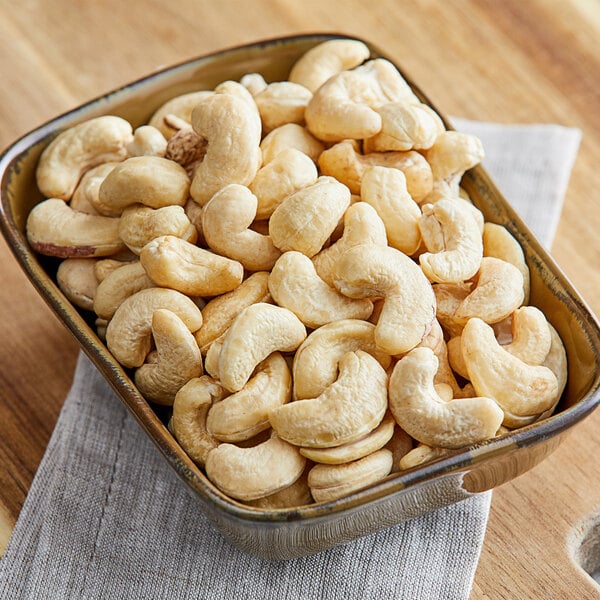
Scientifically named Anacardium occidentale, cashews grow on the cashew tree, which produces cashew apples in addition to the nuts. The cashew nut is found at the bottom of the cashew apple. The growing season for cashews varies depending on the region, with some areas producing cashews year-round. However, the peak season for cashew harvesting typically falls between February and May. Cashew nuts are encased by a shell that contains a toxic resin called urushiol, which can cause skin irritation if not properly removed. This is why cashews are typically sold shelled and roasted to ensure they are safe for consumption.
Cashews are distinguished by their kidney-shaped appearance with a smooth texture and a distinct curve at one end. They have a mild, creamy flavor that makes them a versatile ingredient in both savory and sweet dishes. They are commonly used in cooking to add a creamy texture to dishes or as a topping for salads and stir-fries. Cashews are also used to make dairy-free alternatives like cashew milk, cashew yogurt, or cashew cheese.
- What Do Cashews Look Like? Cashews are light beige, kidney-shaped, smooth, and have a slightly curved bottom with a pointed end. Each cashew seed is encased by a hard, gray, and curved shell.
- What Do Cashews Taste Like? Creamy, subtly sweet, and delicate
- Best Uses for Cashews: Cashew butter, curries, cashew dairy alternatives (milk, cheese, yogurt), cashew-crusted proteins, trail mix, yogurt toppings, oatmeal toppings, baked goods
- How to Open Cashews: Sold with shells removed
- How to Store Cashews Cashews should be stored in an airtight container in a cool, dry place away from direct sunlight and heat sources. Refrigeration can help extend the shelf life of cashews, but bring them to room temperature before using them to maintain their optimal taste and texture.
Cashews vs Peanuts
Cashews are kidney-shaped with a smooth texture, while peanuts are round and have a rough outer shell. In terms of taste, cashews are known for their mild, creamy flavor, whereas peanuts have a more earthy and savory taste. However, peanuts are typically more affordable than cashews, making them a cost-effective option for commercial kitchens. It's important to note that peanuts are a common allergen, while cashews are less likely to cause allergic reactions.
Pistachios vs Cashews
Pistachios are prized for their green color and slightly sweet taste that is a great addition to making sweet treats and savory items. Cashews are known for their creamy texture, subtle flavor, and kidney-shape. Cashews are used in a variety of dishes, from stir-fries to curries to nut butter spreads. Regarding pricing, cashews can be cheaper in the U.S. but less so in other parts of the world.
8. Almond
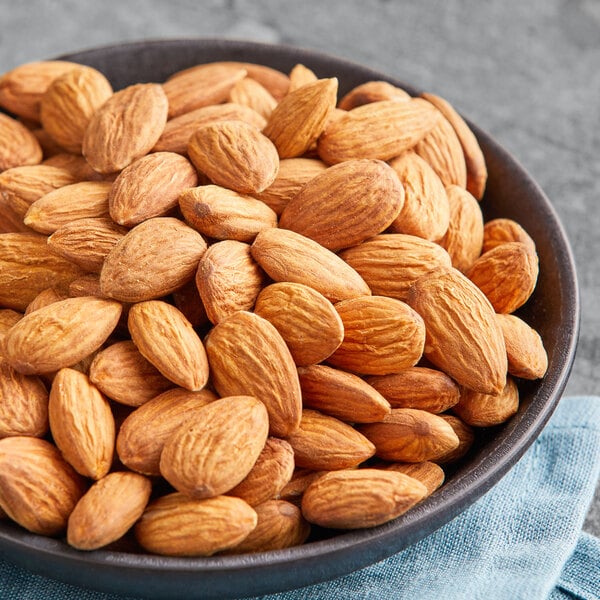
Almonds are the seeds of the Prunus dulcis tree, native to the Middle East and South Asia. They are scientifically named after their tree of origin. Almonds have a distinctive oval shape with a pointed tip and a smooth, light brown outer shell. They are typically harvested in late summer, with the growing season spanning from mid-February to mid-April. Due to their nutritional value and perceived health benefits, almonds are a popular choice for snacks and as an ingredient in health-conscious recipes.
Almonds have a mild, slightly sweet flavor profile paired with a crunchy, chewy texture. They are enjoyed in various forms, including raw, roasted, sliced, and ground into flour. They are commonly used in baking, confectionery, and as a topping for salads, yogurt, and oatmeal. Almonds are converted into almond flour by finely grinding blanched almonds. Almond flour is one of the most popular gluten free flours for Celiac friendly baking.
- What Do Almonds Look Like? Almonds are oval-shaped nuts with a pointed tip and a flat side. In their shell, almonds have a hard, woody exterior that protects the edible seed inside. Once removed from the shell, almonds reveal a light brown color with a smooth, slightly wrinkled surface.
- What Do Almonds Taste Like? Mild and sweet
- Best Uses for Almonds: Baking, salads, yogurt toppings, oatmeal toppings, ground into flour, plant-based dairy products
- How to Open Almonds: Almonds have a hard shell that can be challenging to crack open by hand, so it is most efficient to use a nutcracker. Place the almond in the nutcracker and gently apply pressure until the shell cracks open, revealing the nut inside.
- How to Store Almonds: Almonds have a high oil content and can go rancid if exposed to heat or moisture, so keep them in an airtight container in a cool, dry place away from direct sunlight. To extend their shelf life, store them in the refrigerator or freezer.
Pistachios vs Almonds
While almonds are typically oval-shaped with a smooth surface, pistachios have a more oblong shape with a slightly pointed end. Pistachios are further distinguished by their vibrant green hue and possess a subtly sweet taste profile frequently used in desserts such as ice creams, pastries, and cakes, as well as in savory dishes like salads, pilafs, and pestos. Almonds boast a nutty and earthy flavor with a hint of sweetness commonly featured in baked goods such as cookies, cakes, and bread, as well as in salads, trail mixes, and nut butter. Almonds are often favored for their affordability compared to pistachios, making them a practical choice for businesses seeking to incorporate nuts into their offerings without exceeding their budget.
Peanuts vs Almonds
Peanuts, actually legumes, are characterized by their two-seeded pods that develop underground. Almonds are tree nuts with a hard shell encasing a single seed. Peanuts have a richer, beany, and earthy taste compared to almonds, which have a milder and slightly sweet flavor profile and crunchier texture. Peanuts, often used in the form of peanut butter, are a versatile ingredient in baked goods, sauces, and snacks. Almonds, known for their crunchy texture and mild flavor, are commonly used in confectionery, trail mixes, and as a topping for salads and desserts. Peanuts are more cost-effective, making them a popular option for businesses optimizing their budget.
9. Macadamia
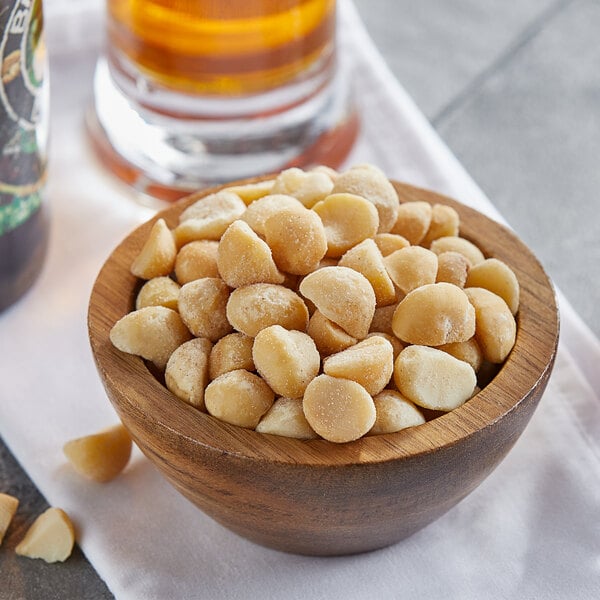
Macadamia nuts, scientifically known as Macadamia integrifolia, are commonly referred to as bush nuts or Queensland nuts. These nuts are primarily grown in regions with a tropical climate, such as Hawaii and Australia. The growing season for macadamia nuts typically occurs between fall and winter. Macadamia nuts are easily recognizable due to their hard shell and round shape, which sets them apart from other types of nuts.
Macadamia nuts have a rich, buttery flavor, making them a favorite ingredient in both sweet and savory dishes. When you first bite into a macadamia nut, you'll experience a delicate crunch, followed by a smooth, creamy mouthfeel. They are often used in baking, confectionery, and as a topping for salads or desserts. In Hawaii, macadamia nut pie Co Poi Kulolo is a beloved delicacy. Additionally, macadamia nuts are a popular choice for snacking and can be enjoyed on their own or as part of a trail mix.
- What Do Macadamia Nuts Look Like? Macadamia nuts are round, creamy white nuts encased in a hard, brown shell.
- What Do Macadamia Nuts Taste Like? Creamy, buttery, smooth, and sweet
- Best Uses for Macadamia Nuts: Chocolate-covered macadamia nuts, baked goods, confectionary items, salad toppings, trail mix, and charcuterie boards
- How to Open Macadamia Nuts: Macadamia nut shells are one of the hardest to crack, requiring a special nutcracker or machinery for processing. They are typically sold without their shells.
- How to Store Macadamia Nuts: Store macadamia nuts in an airtight container in a cool, dark place away from sunlight and heat sources. Refrigeration is recommended for long-term storage, extending the nuts' shelf life and preventing them from turning rancid. Avoid storing macadamia nuts near strong-smelling foods, as they can easily absorb odors.
Raw vs Roasted Macadamia Nuts
Roasting macadamia nuts can greatly enhance their oil-rich flavor. The amount of nutrients that roasted macadamia nuts retain compared to raw macadamia nuts depends on the temperature at which they are roasted. As long as roasted macadamia nuts are cooked at a low temperature, they retain the same nutritional benefits as raw macadamia nuts.
Macadamia Nuts vs Hazelnuts
Macadamia nuts are round and smooth, while hazelnuts have a more oblong shape with a rougher texture. In terms of flavor, macadamia nuts are known for their rich, buttery taste, whereas hazelnuts offer a slightly sweet flavor profile with chocolate essences. Macadamia nuts' higher price point compared to hazelnuts may influence purchasing decisions for commercial applications.
10. Pine Nuts
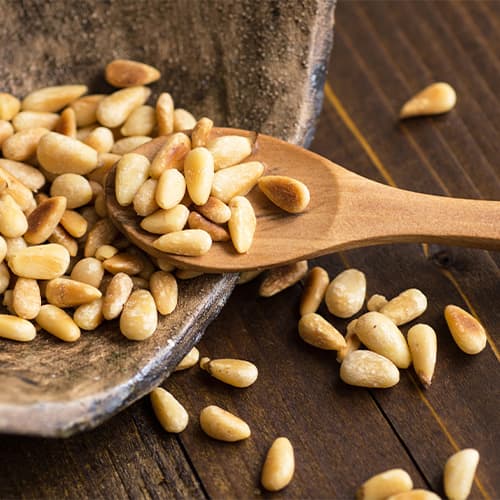
Pine nuts, also known as pignoli or pinon nuts, are the edible seeds of pine trees. While there are many species of pine trees, the most commonly harvested pine nuts come from the stone pine or pinyon pine trees. The scientific name for the stone pine is Pinus pinea, and for the pinyon pine, it is Pinus edulis. Pine nuts are typically harvested in the late summer to early fall, making them a seasonal delicacy.
One of the distinctive features of pine nuts is their elongated, teardrop shape. They have a creamy white color with a softer texture than other seeds. Pine nuts have a mild, buttery taste with a hint of resinous sweetness. They are commonly used in Mediterranean cuisine, particularly in dishes like salads, baked goods, and pesto pasta sauce.
- What Do Pine Nuts Look Like? Encased in a hard shell within certain species of pine cones, pine nuts are small tear-drop-shaped seeds with a pale yellow-white color.
- What Do Pine Nuts Taste Like? Buttery, rich, creamy, slightly sweet, and milky
- Best Uses for Pine Nuts: Salad topping, pasta topping, pesto, baking, Pinolate cookies
- How to Open Pine Nuts: If eaten as a snack, you can crack them open with your teeth like a sunflower seed. If using them in a recipe, hold the pine nut between your thumb and forefinger and apply gentle pressure on the shell while rolling it between your fingers until it pops open. Save time by purchasing shelled pine nuts.
- How to Store Pine Nuts: Keep pine nuts in an airtight container in a cool, dark place, away from heat and sunlight. Refrigeration can extend their shelf life, but bring them to room temperature before using them to preserve their flavor. Additionally, freezing pine nuts can help prolong their freshness, but tightly seal them to prevent moisture absorption.
Pinon Nuts vs Pine Nuts
Pinon nuts are a specific type of pine nut with a unique flavor profile. The term "pinon nuts" refers to the edible seeds from the pinon pine tree, native to the American Southwest. They are prized for their richer, more buttery flavor. Pinon nuts also have a higher fat content than other varieties. Generic "pine nuts" are typically sourced from other pine tree species worldwide and offer a milder taste. Generic pine nuts are also less expensive, making them a more approachable choice for commercial kitchens.
Back to TopWhether you're looking for the rich and buttery taste of macadamia nuts, the versatility of almonds, or the meaty texture of walnuts, each type of nut offers unique benefits. By understanding the differences between various nuts, you can choose the best variety to elevate the taste and texture of your dishes. While they're delicious and nutritious, nuts are also a common allergen, so take steps to prevent cross-contamination when using them in your commercial kitchen.





